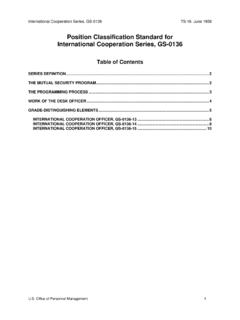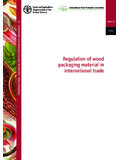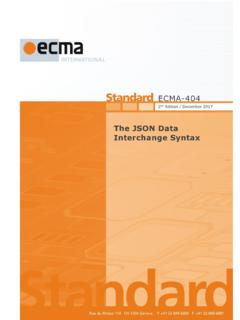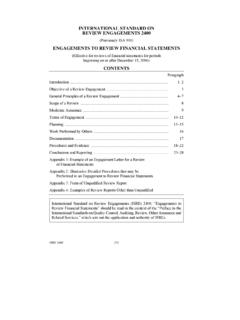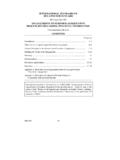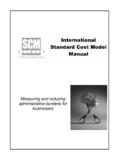Transcription of INTERNATIONAL ISO STANDARD 7730 - …
1 INTERNATIONAL ISO. STANDARD 7730 . Third edition 2005-11-15. Ergonomics of the thermal environment Analytical determination and interpretation of thermal comfort using calculation of the PMV and PPD. indices and local thermal comfort criteria Ergonomie des ambiances thermiques D termination analytique et interpr tation du confort thermique par le calcul des indices PMV et PPD et par des crit res de confort thermique local This is a free 7 page sample. Access the full version online. Reference number ISO 7730 :2005(E). ISO 2005. ISO 7730 :2005(E).
2 PDF disclaimer This PDF file may contain embedded typefaces. In accordance with Adobe's licensing policy, this file may be printed or viewed but shall not be edited unless the typefaces which are embedded are licensed to and installed on the computer performing the editing. In downloading this file, parties accept therein the responsibility of not infringing Adobe's licensing policy. The ISO Central Secretariat accepts no liability in this area. Adobe is a trademark of Adobe Systems Incorporated. Details of the software products used to create this PDF file can be found in the General Info relative to the file; the PDF-creation parameters were optimized for printing.
3 Every care has been taken to ensure that the file is suitable for use by ISO member bodies. In the unlikely event that a problem relating to it is found, please inform the Central Secretariat at the address given below. This is a free 7 page sample. Access the full version online. ISO 2005. All rights reserved. Unless otherwise specified, no part of this publication may be reproduced or utilized in any form or by any means, electronic or mechanical, including photocopying and microfilm, without permission in writing from either ISO at the address below or ISO's member body in the country of the requester.
4 ISO copyright office Case postale 56 CH-1211 Geneva 20. Tel. + 41 22 749 01 11. Fax + 41 22 749 09 47. E-mail Web Published in Switzerland ii ISO 2005 All rights reserved ISO 7730 :2005(E). Contents Page iv Introduction .. v 1 Scope .. 1. 2 Normative references .. 1. 3 Terms and 1. 4 Predicted mean vote (PMV) .. 2. 5 Predicted percentage dissatisfied (PPD).. 4. 6 Local thermal discomfort .. 6. 7 Acceptable thermal environments for 10. 8 Non-steady-state thermal environments .. 11. 9 Long-term evaluation of the general thermal comfort 11.
5 10 Adaptation .. 12. Annex A (informative) Examples of thermal comfort requirements for different categories of environment and types of 13. Annex B (informative) Metabolic rates of different 18. Annex C (informative) Estimation of thermal insulation of clothing ensembles .. 19. Annex D (normative) Computer program for calculating PMV and 23. Annex E (normative) Tables for determination of predicted mean vote (PMV) .. 26. Annex F (informative) Humidity .. 44. Annex G (informative) Air 45. Annex H (informative) Long-term evaluation of the general thermal comfort 47.
6 Bibliography .. 49. This is a free 7 page sample. Access the full version online. ISO 2005 All rights reserved iii ISO 7730 :2005(E). Foreword ISO (the INTERNATIONAL Organization for Standardization) is a worldwide federation of national standards bodies (ISO member bodies). The work of preparing INTERNATIONAL standards is normally carried out through ISO. technical committees. Each member body interested in a subject for which a technical committee has been established has the right to be represented on that committee. INTERNATIONAL organizations, governmental and non-governmental, in liaison with ISO, also take part in the work.
7 ISO collaborates closely with the INTERNATIONAL Electrotechnical Commission (IEC) on all matters of electrotechnical standardization. INTERNATIONAL standards are drafted in accordance with the rules given in the ISO/IEC Directives, Part 2. The main task of technical committees is to prepare INTERNATIONAL standards . Draft INTERNATIONAL standards adopted by the technical committees are circulated to the member bodies for voting. Publication as an INTERNATIONAL STANDARD requires approval by at least 75 % of the member bodies casting a vote.
8 Attention is drawn to the possibility that some of the elements of this document may be the subject of patent rights. ISO shall not be held responsible for identifying any or all such patent rights. ISO 7730 was prepared by Technical Committee ISO/TC 159, Ergonomics, Subcommittee SC 5, Ergonomics of the physical environment. This third edition cancels and replaces the second edition (ISO 7730 :1994), which has been technically revised. A method for long term evaluation has been added, as well as information on local thermal discomfort, non-steady-state conditions and adaptation, and an annex stating how thermal comfort requirements can be expressed in different categories.
9 This is a free 7 page sample. Access the full version online. iv ISO 2005 All rights reserved ISO 7730 :2005(E). Introduction This INTERNATIONAL STANDARD covering the evaluation of moderate thermal environments was developed in parallel with the revised ASHRAE1) STANDARD 55 and is one of a series of ISO documents specifying methods for the measurement and evaluation of the moderate and extreme thermal environments to which human beings are exposed (ISO 7243, ISO 7933 and ISO/TR 11079, all three dealing with extreme environmental conditions, are others in the series).
10 A human being's thermal sensation is mainly related to the thermal balance of his or her body as a whole. This balance is influenced by physical activity and clothing, as well as the environmental parameters: air temperature, mean radiant temperature, air velocity and air humidity. When these factors have been estimated or measured, the thermal sensation for the body as a whole can be predicted by calculating the predicted mean vote (PMV). See Clause 4. The predicted percentage dissatisfied (PPD) index provides information on thermal discomfort or thermal dissatisfaction by predicting the percentage of people likely to feel too warm or too cool in a given environment.
